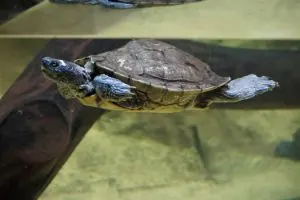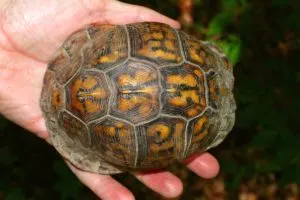Different turtle species grow at different rates.
Understanding the growth and health of pet turtles, including young turtles and female turtles, is crucial for turtle owners. This article also touches on different species of turtles, like sea turtles and eastern box turtles, emphasizing the importance of factors like proper diet and environmental conditions for their growth and overall health.
Knowing how fast your turtle grows allows you to plan ahead. You can safely approximate when your turtle will outgrow their tank.
A lot goes into the growth rate of turtles apart from just genetics. The more you feed your turtle, the faster it will grow. Likewise, if you feed your turtle less, the growth rate will be slower.
Table Of Contents
- How Fast Do Red-Eared Sliders Grow?
- How Fast Do Painted Turtles Grow?
- How Fast Do Snapping Turtles Grow?
- How Fast Do Map Turtles Grow?
- How Fast Do Box Turtles Grow?
- Factors That Affects A Turtle’s Growth Rate
Providing the turtle with a stress-free environment with the right exposure to UVB/UVA light, the right temperatures, and access to hiding spots will ensure your turtle grows as it should.
While you may be tempted to overfeed your turtle so it grows faster, that isn’t advisable as rapid growth can negatively affect the physical development of the chelonian.
Like people turtles get fat too, and it also isn’t good for them.
Since most freshwater turtles are small to medium-sized, expect a growth rate of about 1 – 2 cm per year.
How Fast Do Turtles Grow?
In this section, we will explore the growth rates of various turtles, focusing on species such as red-eared sliders, painted turtles, snapping turtles, and map turtles. Our discussion will include the growth stages from the egg stage to full maturity, highlighting the differences in growth rates between younger turtles and adult turtles.
Growth Rate Of Popular Pet Turtle Species
How Fast Do Red-Eared Sliders Grow?

Red-eared sliders grow the fastest within the first few years of their lives. Expect them to grow to around 3 to 4 cm (1.1 to 1.6 inches) within the very first year.
By age 2, they can reach lengths of 6 cm (2.3 inches). By age 3, the red-eared slider should reach a length of 10 cm (4 inches). By age 4, the slider should reach a length of about 11.5 cm (4.5 inches).
Red-eared sliders are generally mature enough to breed at a length of 10 cm (4 inches) for males and 15 cm (6 inches) for females. They typically reach this length at the age of 5 to 6 years.
It can take about 8 years for red-eared sliders to reach their full length, which is generally between 18 to 30 cm (7 to 12 inches).
Of course, the growth rate varies from one individual to another. Variations are usually by an inch or 2.
Red Eared Slider Growth Chart In Years
| Age | Average Shell Length (cm) |
| 1 | 4 |
| 2 | 6 |
| 3 | 10 |
| 4 | 11.5 |
| 5-6 | 15 |
How Fast Do Painted Turtles Grow?

Painted turtles (Chrysemys picta) grow fastest as juveniles. These turtles have an average juvenile growth rate of about 12.3 mm (1.2 cm) per year. After reaching sexual maturity at about age 10, the growth rate would have fallen to 1.2 mm (0.1 cm) per year.
Upon hatching, the painted turtle would be just a couple of centimeters in length. By age 1, you can expect the turtle to have grown to around 5 cm (2 inches). By age 2, it would be about 7 cm (2.7 inches) in shell length.
By age 4, the painted turtle can be expected to reach a length of 8 cm and by age 5 around 9 cm (3.1 inches).
Painted turtles usually reach sexual maturity at around age 10. At this age, the turtle would be about 12 cm (4.7 inches) in shell length. However, the turtle doesn’t stop growing. Over the next 10 years, expect the turtle to grow an additional 3 cm.
The final shell length of an average painted turtle is 15 cm (6 inches). However, the size range of an adult C. picta is 10 to 25 cm (4 to 10 inches).
Painted Turtle Growth Chart In Years
| Age | Average Shell Length (cm) |
| 1 | 5 |
| 2 | 7 |
| 4 | 8 |
| 10 | 12 |
| 20 | 15 |
How Fast Do Snapping Turtles Grow?

Snapping turtles are widely kept as pets. These turtles are voracious eaters. In captivity, they are prone to overeating and growing very quickly. This is particularly true of captive snapping turtles.
As with many other turtles, snapping turtles grow fastest when young. Of course, each individual snapping turtle will grow at a different rate depending on how much you feed them.
Within the first two years, the common snapping turtle will grow to 12 to 15 cm (5 to 6 inches ) in shell length, on average. Over the next 15 to 20 years, the turtle will only grow an additional 30 to 35 cm (12 to 14 inches) in shell length.
In all, adult common snapping turtles can reach shell lengths of 45 cm (19 inches) and weights of 40 kg (86 lbs).
Snapping Turtle Growth Chart In Years
| Age | Average Shell Length (cm) |
| 2 | 12 |
| 20 | 45 |
How Fast Do Map Turtles Grow?

Common map turtle (Graptemys geographica) are small turtles. An adult male usually measures about just 4 inches. Females on the other hand are much bigger, with adults obtaining lengths of 7 to 10 inches.
Upon hatching, male map turtles have an average plastron length of 3 cm, while females measure 2 cm on average.
By age 1, males grow to a plastron length of about 4.2 cm (1.6 inches), while females grow to a length of 4.4 cm (1.7 inches). By age 2, males’ plastron length will on average be 6 cm (2.3 inches), the same length is true for females as well.
By age 4, expect the male’s plastron to be 7.5 cm (3 inches) in length, with the average female’s plastron measuring 9.7 cm (3.8 inches). By this age, the female should be much bigger than the male.
By age 5, the male would measure about 8 cm (3 inches), and the female should measure about 11 cm (4.3 inches). Males should have reached maturity at age 5 to 6. Females reach maturity at about age 10 and at a length of about 18 to 21 cm (7 to 8 inches).
Map Turtle Growth Chart In Years
| Age | Average Male Plastron Length (cm) | Average Female Plastron Length (cm) |
| 1 | 4 | 4 |
| 2 | 6 | 6 |
| 3 | 7 | 8 |
| 4 | 7.6 | 9.6 |
| 5 | 8.1 | 11 |
| 6 | — | 13 |
| 7 | 8.4 | 14 |
| 8 | — | 16 |
| 9 | — | 18 |
| 10 | — | 18 |
How Fast Do Box Turtles Grow?

As with the other turtles mentioned, common box turtles (Terrapene carolina) grow the fastest when they are young.
The older they get, the slower their growth rate. During the early stages (between ages 0 and 5), expect the common box turtle to grow at a rate of about 10 mm (1 cm) a year.
Between ages 5 and 10, expect the turtle to grow at a rate of just 8 mm (0.8 cm) per year. From age 10 to 15, expect the turtle to grow at a rate of about 2.5 mm (0.2 cm) per year.
Hatchlings have a carapace length of about 2.5 cm (1 inch). Expect the turtle to grow steadily over the next 5 years. By age 5, the chelonian should have attained a carapace length of about 7.5 cm (3 inches).
This steady growth should continue over the next 5 years. By age 10, the common box turtle should have attained a carapace length of about 12.3 cm (4.8 inches).
Growth will slow down significantly from here with the turtle growing a few additional centimeters over the rest of its life.
By maturity, which should be between the ages of 7 and 10, expect the turtle to reach carapace lengths of 12.7 cm to 15 cm (5 to 6 inches).
Box Turtle Growth Chart In Years
| Age | Average Shell Length (cm) |
| 0 | 2.5 |
| 5 | 7.5 |
| 10 | 12.3 |
Factors That Affects A Turtle’s Growth Rate
Healthy Diet
You can never underestimate the importance of a healthy diet. If you want your turtle to grow at the right rate, then you have to feed them accordingly.
And you can’t feed all turtles the same diet. What you feed your turtle should be determined by the species. From aquatic plants in North America to diverse diets elsewhere, turtles can be herbivorous, omnivorous, or carnivorous. A balanced diet is an important factor for a healthy shell and overall growth.
You need to do your research. For instance, painted turtles require a diet with a protein ratio of 30 to 40 percent, while box turtles require a diet with a protein ratio of about 60 percent.
Also, juveniles generally require more protein than adults do. For example, box turtle hatchlings require a diet with a protein ratio of 70 to 75 percent.
Also, a strict feeding schedule should be maintained. While most juvenile turtles need to be fed once a day, most adults must be fed about twice a week.
Genetics (Species/Subspecies)
Different species and subspecies grow at different rates. Similarly, two turtles of the same sex & subspecies fed the same diet and kept in the same habitat may grow at different rates.
Check our guide to determine your turtles gender.
Each individual turtle is unique just like humans. Also, different species and subspecies grow at different rates. For example, at age 2, the average common snapping would have attained a length of 12 cm.
Compare this to a red-eared slider that will only reach a shell length of 12 cm at age 4.
Environmental Conditions
In addition to diet, environmental factors such as UVB light exposure are crucial. For instance, turtles living in a cold climate require special care, while those in natural habitats like the eastern United States face different challenges. The right habitat, including a basking area and exposure to UVB rays, is an important thing for preventing metabolic bone disease, especially in pet box turtles and wild box turtles.
Along with maintaining UV exposure, you’ll also need to keep a close eye on water quality, and quantity, enclosure space, hiding spots, basking spot, and temperature are all important to successful growth. The right amount of UV exposure ensures that the turtle grows at the right rate and as it’s supposed to.
Lack of UVB and UVA can lead to shell pyramiding and metabolic bone disease. Clean water ensures the turtle remains healthy and that in turn influences growth.
Enclosure space is also very important. If the turtle’s living quarters are too small, it hampers growth.
Keeping the turtle healthy and stress-free will allow it to grow at a steady rate.
Metabolic Bone Disease in Turtles
A significant concern for turtle owners is metabolic bone disease, commonly seen in turtles not receiving proper care. Factors contributing to this condition include inadequate UVB light, poor diet, and lack of a nutritious diet. Turtles, particularly pet turtles and different species of turtles like male map turtles or wild turtles with fewer predators, need a well-balanced diet and proper UVB exposure to maintain their turtle’s carapace and overall health. Older turtles and those reaching full size, such as adult females, require consistent monitoring to ensure long life and avoid signs of illness.
Conclusion
Furthermore, understanding the average growth rate and factors influencing the growth of a turtle, such as the sex of the turtle and nutritional requirements like how much protein they need, can help in providing proper care. For species like leatherback sea turtles or land-based turtles like baby box turtles, each has unique requirements that influence their years of life.
Knowing the growth rate of a turtle allows you to plan ahead. As a rule of thumb for every inch, you need to increase the turtle’s tank capacity by at least 10 to 15 gallons.
With this in mind, you can easily determine how quickly a turtle will outgrow its tank. Alternatively, you can also choose the tank size for when the turtle’s eventual length.
The growth rate can also help you approximate when the turtle will be mature enough to breed.
However, just like humans individuals, turtles that belong to the same species may grow at different rates. In this article, I approximate the growth rate.
As such your turtle may grow slower or faster than stated here. Regardless, the information should give a fair idea about what to expect.
If you have any information or questions, kindly leave a comment.

Della
Thursday 18th of May 2023
This was really helpfull
Jennifer McConnell
Monday 29th of March 2021
Thank you, very informarive!